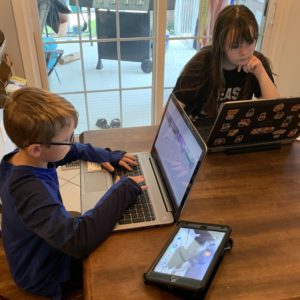NH Students Getting Help Closing COVID Learning Gap

To close the learning gaps caused by the COVID-19 pandemic school shutdowns, New Hampshire’s Education Commissioner Frank Edelblut announced a new program to offer a 24-hour tutoring service for up to 100,000 students.
“New Hampshire is stepping up to help students not only recover but reach even higher academic goals,” Edelblut said.
So far, 25 schools have registered to take part in the new Tutor.com program, representing opportunities for more than 11,000 students to get the education help they need. Another 40 schools are also in the process of signing up for the program.
Edelblut said eventually the program will be universally available to all New Hampshire 6 through 12 grade students in public, private, charter, and homeschool programs. The Executive Council approved the $4.8 million three-year contract with Tutor.com last month.
Edelblut went to Jaffrey’s Conant High School this week to announce the start of the partnership.
“This program will empower students by providing them with personalized, focused attention from tutors who can assist them with math, English, science, SAT prep, and more,” he said. “This 24/7 resource will provide support to students and their teachers.”
Tutor.com gives students no-cost access to one-to-one tutoring, test prep, and homework help with support in multiple languages. Students may engage with their tutors via two-way text-chat or voice, choosing the communication style that works best for them. Tutors undergo background checks and are rigorously vetted, and they provide support using a Socratic approach that is encouraging and empowering, asking guiding questions to help students understand difficult concepts on their own. School districts are being encouraged to register for Tutor.com’s free access for their students; students outside of those districts will be able to register individually.
“We are proud to partner with NHED to support middle and high school students across the state. We are dedicated to helping students achieve their academic goals and to reducing the stress on learners, families, and teachers,” said Sandi White, Senior Vice President, Institutional Partnerships, Tutor.com.
Test scores are down nationally as a result of the COVID shutdowns, according to data from the National Assessment of Education Progress report. Test scores for students aged 9 declined 5 points in reading and 7 points in math compared to 2020. According to NAEP, that is the largest average score decline in reading since 1990 and the first ever score decline in mathematics
Conant Principal David Dustin said students at his school have been struggling since the pandemic shutdowns and teachers have worked hard to get them up to speed. The COVID learning gaps have put many students in education holes that are hard for even dedicated teachers to handle alone, he said.
“They do whatever they can to help their students and still they can’t meet the needs of all their students.
Tutor.com will help support teachers, as well as parents who are working to get their children back on the right track.
“We know our parents in our community really want their children to succeed,” Dustin said. “This tool will help them.”
The tutoring program is being funded with federal COVID relief money, and Edelblut said the expectation is to close the learning gaps that exist by the time the contract is done in 2025.
“The goal for all of us as educators is to really try and close those learning gaps,” Edelblut said. “We don’t expect that our students 10 years from now are going to be suffering from those learning gaps. We’re trying to close those gaps now.”




